
Typhoon Kujira, known in the Philippines as Typhoon Dante, was first reported by the Joint Typhoon Warning Center (JTWC) on April 28. It was the fourth depression and the first typhoon of the season. The disturbance dissipated later that day however it regenerated early on April 30 within the southern islands of Luzon. It was then designated as a Tropical Depression during the next morning by the Philippine Atmospheric, Geophysical and Astronomical Services Administration (PAGASA) and the Japan Meteorological Agency (JMA), with PAGASA assigning the name Dante to the depression. However the JTWC did not designate the system as a depression until early on May 2 which was after the depression had made landfall on the Philippines. Later that day Dante was upgraded to a Tropical Storm and was named as Kujira by the JMA. The cyclone started to rapidly intensify becoming a typhoon early on May 4, and then reaching its peak winds of 155 km/h (100 mph) (10-min), 215 km/h (135 mph) (1-min) later that day after a small clear eye had developed.

The 2013 Pacific typhoon season was a devastating and catastrophic season that was the most active since 2004, and the deadliest since 1975. It featured Typhoon Haiyan, one of the most powerful storms in history, as well as one of the strongest to make landfall on record. It featured 31 named storms, 13 typhoons, and five super typhoons. The season's first named storm, Sonamu, developed on January 4 while the season's last named storm, Podul, dissipated on November 15. Collectively, the storms caused 6,829 fatalities, while total damage amounted to at least $26.41 billion (USD), making it, at the time, the costliest Pacific typhoon season on record, until it was surpassed five years later. As of 2024, it is currently ranked as the fifth-costliest typhoon season.
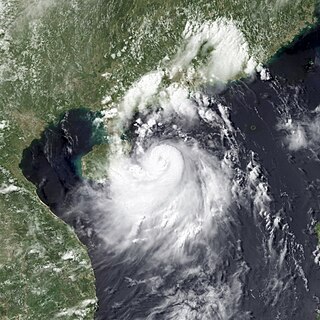
Severe Tropical Storm Rumbia, known in the Philippines as Tropical Storm Gorio, was a tropical cyclone that brought widespread flooding in areas of the Philippines and China late June and early July 2013. The sixth internationally named storm of the season, Rumbia formed from a broad area of low pressure situated in the southern Philippine Sea on June 27. Steadily organizing, the initial tropical depression moved towards the northwest as the result of a nearby subtropical ridge. On June 28, the disturbance strengthened to tropical storm strength, and subsequently made its first landfall on Eastern Samar in the Philippines early the following day. Rumbia spent roughly a day moving across the archipelago before emerging into the South China Sea. Over open waters, Rumbia resumed strengthening, and reached its peak intensity with winds of 95 km/h (50 mph) on July 1, ranking it as a severe tropical storm. The tropical cyclone weakened slightly before moving ashore the Leizhou Peninsula late that day. Due to land interaction, Rumbia quickly weakened into a low pressure area on July 2 and eventually dissipated soon afterwards.

Typhoon Krosa, known in the Philippines as Typhoon Vinta, was a typhoon that made landfall in the northern Philippines in late October 2013. Forming on October 27 near Guam, the storm slowly intensified while moving westward. Krosa developed an eye and became a typhoon before striking Luzon on October 31. The storm weakened over land, but re-intensified over the South China Sea, reaching peak winds of 150 km/h (93 mph) on November 2 off the southeast coast of China. Typhoon Krosa stalled and encountered unfavorable conditions, resulting in quick weakening. By November 3, it had weakened to tropical storm status, and was no longer being warned on by the next day. In northern Luzon, Krosa damaged 32,000 houses, including 3,000 that were destroyed, and caused four fatalities. High winds and rainfall left ₱277 million in damage.

Typhoon Hagupit known in the Philippines as Super Typhoon Ruby, was the second most intense tropical cyclone in 2014. Hagupit particularly impacted the Philippines in early December while gradually weakening, killing 18 people and causing $114 million of damage in the country. Prior to making landfall, Hagupit was considered the worst threat to the Philippines in 2014, but it was significantly smaller than 2013's Typhoon Haiyan.
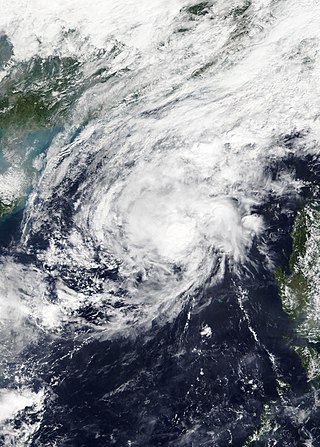
Tropical Storm Haikui, known in the Philippines as Tropical Storm Salome, was a weak tropical cyclone that affected the Philippine archipelagos of Luzon and Visayas. Forming as the twenty-fourth named storm of the 2017 typhoon season, Haikui developed as a tropical depression to the east of Samar on November 9. Traversing some Philippine islands, the system gradually intensified into a named tropical storm by November 10. In that same day, Haikui emerged to the South China Sea. By November 12, the Japan Meteorological History downgraded the storm into a tropical depression. The storm dissipated on November 13, while meteorologists from the USA recorded the storm until November 14.

Tropical Depression Usman was a weak but deadly tropical cyclone that impacted the southern Philippines in December 2018. Tropical Depression Usman originated first as a low-pressure area to the east of Palau on December 23. Slowly intensifying, the system became a tropical depression two days later. The system maintained its intensity while moving in a general west-northwestward direction approaching the eastern portion of the Philippine islands. However, due to unfavorable conditions, the depression weakened into a remnant low on December 29, while making landfall over Eastern Samar thereafter.

Typhoon Vongfong, known in the Philippines as Typhoon Ambo, was a strong tropical cyclone that impacted the Philippines in May 2020. Beginning as a tropical depression on May 10 east of Mindanao, Vongfong was the first storm of the 2020 Pacific typhoon season. It gradually organized as it took a slow northward course, strengthening into a tropical storm on May 12 and curving west thereafter. The next day, Vongfong entered a period of rapid intensification, becoming a typhoon and attaining 10-minute maximum sustained winds of 150 km/h (93 mph). The storm made landfall at this intensity near San Policarpo, Eastern Samar, at 04:15 UTC on May 14. The system tracked across Visayas and Luzon, making a total of seven landfalls. Persistent land interaction weakened Vongfong, leading to its degeneration into a tropical depression over the Luzon Strait on May 17.

Tropical Depression Josie was a weak tropical system that impacted the Philippine archipelago of Luzon in July 2018, bringing widespread flooding. The tropical depression was classified in the South China Sea on July 20, and steadily moved eastward while gradually intensifying. The storm reached its peak intensity of 1-minute sustained winds of 65 km/h while nearing the northern tip of the Ilocos Region. By July 22, the system moved northward and rapidly weakened. The system was last noted on July 23 to the northeast of Taiwan.

Typhoon Goni, known in the Philippines as Super Typhoon Rolly, was an extremely powerful tropical cyclone that made landfall as a Category 5 equivalent super typhoon on Catanduanes in the Philippines, and in Vietnam as a tropical storm. It is the strongest landfalling tropical cyclone on record by 1-minute maximum sustained winds. The name "Goni" means swan in Korean. The nineteenth named storm, ninth typhoon, and second super typhoon of the 2020 Pacific typhoon season, Goni originated as a tropical depression south portion of Guam on October 26. It was then named as Tropical Storm Goni on October 27. On the next day, Goni explosively intensified over the Philippine Sea, becoming a Category 5–equivalent super typhoon on October 30. Goni maintained Category 5 strength for over a day, before making landfall on Catanduanes at peak intensity, with 10-minute sustained winds of 220 km/h (140 mph), and 1-minute sustained winds of 315 km/h (195 mph), with a minimum central pressure of 905 hPa. It was the most intense tropical cyclone observed worldwide in 2020.

The 2024 Pacific typhoon season is an ongoing event in the annual cycle of tropical cyclone formation in the western Pacific Ocean. It is the fifth-latest starting Pacific typhoon season on record, as well as the deadliest since 2013, and the fifth-costliest Pacific typhoon season on record, mostly due to Yagi. This season also saw the most active November on record, with 4 storms active at the same time. The season runs throughout 2024, though most tropical cyclones typically develop between May and October. The season's first named storm, Ewiniar, developed on May 25, and eventually intensified into the first typhoon of the season.
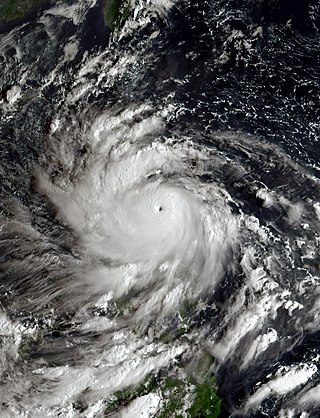
Typhoon Noru, known in the Philippines as Super Typhoon Karding, was an intense and destructive tropical cyclone that affected Vietnam, Thailand, and the Philippines — where it caused widespread agricultural damage. Noru, which means Roe deer in Korean, the sixteenth named storm and eighth typhoon, and third super typhoon of the 2022 Pacific typhoon season, Noru originated from a disturbance over the Philippine Sea, slowly tracking eastward until its development into a tropical depression, where it began to move westward.

Severe Tropical Storm Conson, known in the Philippines as Typhoon Jolina, was a strong tropical cyclone that impacted the central Philippines and Vietnam during the 2021 Pacific typhoon season. Being the thirteenth named storm of the said event, Conson originated as a low-pressure area first monitored approximately 500 km (310 mi) west of Guam. It formed as a tropical depression over the Pacific Ocean on September 5, 2021. As it formed within the Philippine Area of Responsibility, the Philippine Atmospheric, Geophysical, and Astronomical Services Administration (PAGASA) named the storm Jolina. Over the next day, it intensified into a tropical storm and was named Conson by the Japan Meteorological Agency (JMA). As the storm neared Samar Island, it intensified into a severe tropical storm, and later into a typhoon according to the PAGASA prior to its first landfall in Eastern Samar. The storm retained its strength as it crossed Visayas and later Calabarzon before weakening over Manila Bay prior to its final landfall in Bataan. It subsequently emerged into the South China Sea where it struggled to reintensify further. It then weakened into a tropical depression just offshore of Vietnam before moving ashore near Da Nang. It then rapidly weakened before dissipating on September 13.
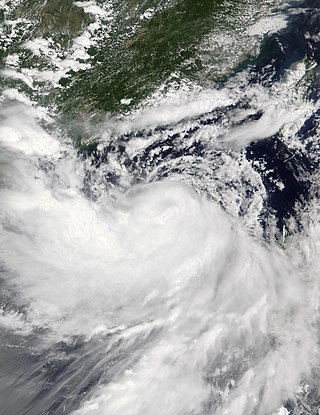
Severe Tropical Storm Ma-on, known in the Philippines as Severe Tropical Storm Florita, was a tropical cyclone that impacted the Philippines in August 2022. The ninth named storm of the 2022 Pacific typhoon season, Ma-on originated as a disturbance over in the Pacific Ocean on August 18, and was upgraded to a tropical depression during the next day. The depression strengthened into a tropical storm receiving the name Ma-on, and became a severe tropical storm late on August 23 before making landfall in the Philippines. It would later make landfall in China and Vietnam on August 25. Ma-on weakened back to a tropical depression and due to unfavorable conditions it dissipated on August 26, 2022.
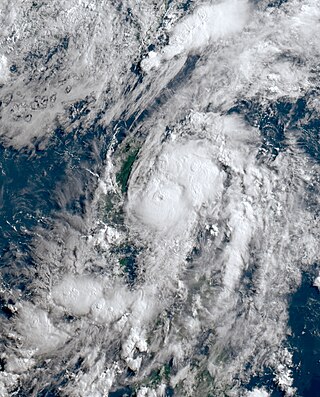
Typhoon Ewiniar, known in the Philippines as Typhoon Aghon, was a fairly strong tropical cyclone that impacted parts of the Philippines, particularly Luzon, in May 2024. The first named storm and typhoon of the annual typhoon season, Ewiniar emerged from an area of atmospheric convection 441 km (274 mi) southeast of Palau. The Japan Meteorological Agency (JMA) labeled the system as a low-pressure area on May 21. It intensified on May 23 and became a tropical depression, giving it the name Aghon by the Philippine Atmospheric, Geophysical, and Astronomical Services Administration after entering the Philippine Area of Responsibility, marking it as the fifth-latest start of a Pacific typhoon season since reliable records began; the depression intensified into a tropical storm, assigning it the name Ewiniar. The cyclone made nine landfalls in the Philippines. Afterward, it began to move over the warm tropical waters of Lamon Bay, where the Joint Typhoon Warning Center and the JMA upgraded Ewiniar into a minimal typhoon. Beginning to weaken for the final time on May 30, the storm passed directly over the island of Minamidaitōjima and began an extratropical transition. It was last noted by the JMA early on June 2, near the International Dateline, and absorbed into another extratropical cyclone just south of Prince William Sound on June 6.

Typhoon Kong-rey, known in the Philippines as Super Typhoon Leon, was a powerful tropical cyclone that impacted Taiwan and the Philippines before later affecting East China, South Korea, and Japan in late October and early November 2024. Kong-rey was the first typhoon in Taiwan's history to make landfall after mid-October and the largest storm to strike since Typhoon Herb in 1996. Additionally, it was the second tropical cyclone in a series to impact the Philippines, following Tropical Storm Trami a few days earlier, and preceding Typhoons Yinxing, Toraji, Usagi, and Man-yi which would impact a few days later.

Typhoon Yinxing, known in the Philippines as Typhoon Marce, was a powerful tropical cyclone that impacted the Philippines before later affecting Vietnam in early November 2024. It was the third tropical cyclone in a series to impact the Philippines, following Tropical Storm Trami and Typhoon Kong-rey a few days earlier, and Typhoons Toraji, Usagi, and Man-yi only a few days after. Additionally, it was also part of the four tropical cyclones to simultaneously exist in the Western Pacific during the month of November, the first occurrence since records began in 1951; the other three were Toraji, Usagi and Man-yi.

Typhoon Toraji, known in the Philippines as Typhoon Nika, was a fairly strong tropical cyclone that impacted the Philippines in early November 2024. It was the fourth tropical cyclone in a series to impact the Philippines, following Tropical Storm Trami and Typhoons Kong-rey, Yinxing, Usagi, and Man-yi which had occurred just a few days earlier. Additionally, it was also part of the four tropical cyclones to simultaneously exist in the Western Pacific during the month of November, the first occurrence since records began in 1951; the other three were Yinxing, Usagi and Man-yi.

Typhoon Man-yi, known in the Philippines as Super Typhoon Pepito, was a powerful and long-tracked tropical cyclone that impacted the Philippines in early November 2024. Closely following Tropical Storm Trami and Typhoons Kong-rey, Yinxing, Toraji and Usagi, Man-yi became the sixth consecutive tropical system to affect the country in less than a month. It was also part of the four tropical cyclones to simultaneously exist in the Western Pacific during the month of November, the first occurrence since records began in 1951; the other three were Yinxing, Toraji, and Usagi.

Typhoon Usagi, known in the Philippines as Super Typhoon Ofel, was a powerful tropical cyclone that impacted the Philippines before later affecting Taiwan in early November 2024. It was the fifth of six consecutive tropical cyclones that impacted the Philippines within a span of four weeks, following Tropical Storm Trami and Typhoons Kong-rey, Yinxing, and Toraji, and preceding the stronger Typhoon Man-yi. Additionally, Usagi was also part of the four tropical cyclones to simultaneously exist in the Western Pacific during the month of November, the first time since records began in 1951; the other three were Yinxing, Toraji and Man-yi.






























